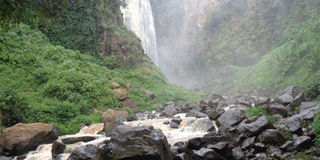The forest of the elephants

Thomson's Falls Nyahururu. PHOTO | RUPI MANGAT
What you need to know:
- “There are so many medicinal plants here. So the female chews them and feeds them to the calf. It’s like inoculating babies.” Impressive. “If it’s a kike (female), the mother will nurse her three months. If it’s a male calf, she will nurse him for one month.”
It’s night time in Nyahururu. The roar of the falls fills the air. It’s biting cold but refreshing, standing on the balcony of my room at the Panari Resort overlooking the gorge where the waters of the Ewaso Narok cut through. The force of the falls catapulting 200 feet (74 meters) for thousands of years has created a dramatic gorge for the river to flow on and meet the Ewaso Nyiro – and finally disappear into the little visited Lorian Swamp.
At breakfast I hear that the forests of Rumuruti and Marmanet are elephant maternity wards where females come to deliver and nurse their young. So excited am I that l forgo a hot-stone massage for Rumuruti Forest despite rain clouds in the sky.
Joshua Koskei of Rumuruti Forest Association leads through the forest of red cedar trees. We get to one of the few swamps within, where a pair of Grey crowned cranes strut. George Ndung’u announces that it’s a mating pair with a nest in the swamp. A bird with scarlet underwing flies into the forest. It’s a Hartlaub’s turaco. Sun bleached white bones of an elephant rest on the earth. Benson Mbitsi, our driver, spots the enormous skull of an elephant in the thickets camouflaged in the thickets. It’s an interesting mix of sights here.
IMMUNIZATION HERBS
Joyce Wathira Muiruri and Joseph Kigera Theuri of the forest association lead us to a ‘maternity’ ward. “We know our elephants by sight,” says Theuri. “The most notorious were John Killer (named for killing villagers) and Kipchoge.”
“This is one of the places they give birth,” Wathira continues. “There are so many medicinal plants here. So the female chews them and feeds them to the calf. It’s like inoculating babies.” Impressive. “If it’s a kike (female), the mother will nurse her three months. If it’s a male calf, she will nurse him for one month.”
Murphy’s law. Returning to our hotel, we hear that an elephant herd was browsing by the fence in the morning. Understandably we rush out again – there’s plenty of evidence that the elephants have been browsing with all the trampled bushes. But the elephants themselves are nowhere to be seen.
Either way, it’s lunch with hot kebabs and moushkaki, fresh soups and desserts, and vegetarian fare from one kitchen that is exclusively dedicated to veg. After lunch, we shall climb down 200 feet to the bottom of Thomson’s Falls.
The track is training ground for the Kenya army. Ndung’u and I meet some soldiers running up and down without a problem while I inch my way over steep boulders on a slippery path – with the rain clouds threatening to burst any time.
At the bottom of the gorge, spray mist rises off where the falls crash. When explorer Joseph Thomson saw the falls in October 1883 he named the falls Thomson’s Falls – after himself. At the time, the area was a no-man’s land between two warring Maasai clans, and they called the place ‘naiurru-ur’ – for waterfalls. Thomson heard it as ‘ururu’ from which Nyahururu gets its name.
Back up, we walk to the Hippo Pool across the road from Panari, close to 7pm and in time to watch a pod of 10 hippos surface for air, yawn and get ready for the night out to feed.
Finally, it’s diva day. After two days of trampling through forests and the falls, a hot-stone massage is spot on, followed by a pedicure so deserved. Meanwhile outside, the skies have opened and thunder bolts through the skies.




